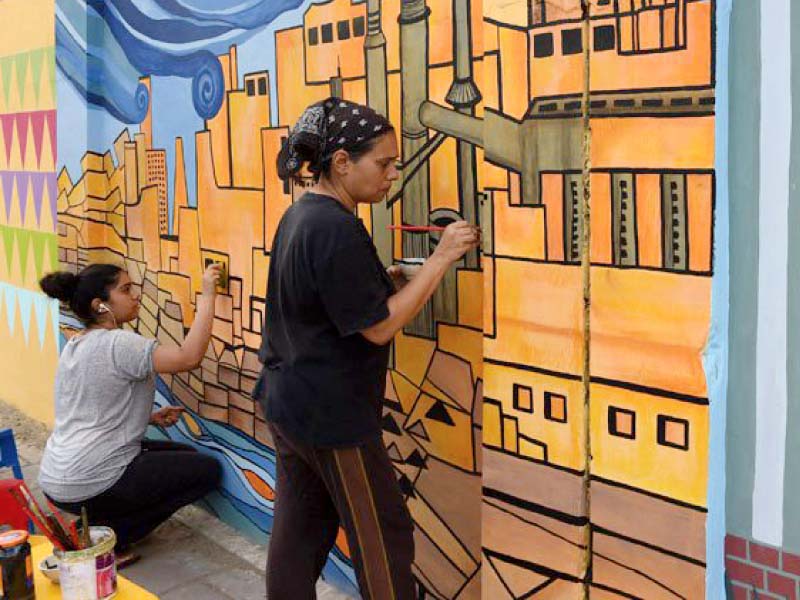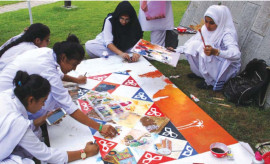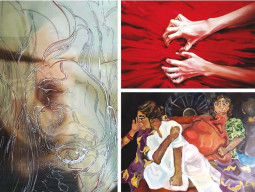
KARACHI: Art has always been vibrant in Karachi and affected by political upheavals, asserts Noorjehan Bilgrami, director and curator of Koel Art Gallery. "In the last 20 years, art education institutions have played a pivotal role in enhancing the art scene. Young graduates, artists and the mushrooming of art galleries have all added to the pulsating art scene," she said while discussing the city's art scene with The Express Tribune.
Sensory perceptions: Promising artists to exhibit work on ‘facial familiarity’
Abid Merchant of the Sanat Initiative said art in Karachi has always thrived. "Many of Pakistan's earliest artists lived and worked in Karachi soon after partition. Fyzee Rahamin, who was living and working in London and New York, came to Karachi in 1947 where he settled and spent the rest of his life," he shared.
"Artists AS Nagi, Laila Shehzada, Bashir Mirza, Ali Imam, Sadequain and Gulgee are just a few of the prolific and known artists to have lived and worked in Karachi," said Merchant.
He explained that Pakistan's first private arts education institution, the Meena School of Art (now Karachi School or Art), was founded in Karachi in 1964 by sisters Rabia Zuberi and Hajra Mansur. "[One of] Pakistan's first commercial art galleries, Indus Gallery, was established by the late Ali Imam in Karachi in 1970."
Awareness
Art awareness, however, is a relatively new phenomenon in Karachi, according to Canvas Gallery curator Sameera Raja. The lack of major art schools in Karachi, such AS Lahore's National College of Arts, until around 20 years ago when the Indus Valley School of Art and Architecture was established, played a role in this regard, she said.
"The arts have been picking up on two fronts: education and the exhibition and sale of art," explained Merchant. "Art education has slowly been picking up, with a number of art colleges and universities being established over the decades all over Pakistan. Along with new institutes being established, existing universities and colleges have been adding fine arts departments or have started offering fine arts classes as a part of their humanities curriculum," he said.
Pakistani musician selected for artist residency in San Francisco
"As for established, mid-career and emerging artists who need continuing arts instruction and education opportunities, there are a growing number of residencies being initiated by artists, artist-collectives, galleries and even educational institutes."
According to Merchant, why this is worth mentioning is because the academic value of an education in fine arts is being recognised and the viability of a career after studying fine arts is becoming acknowledged.
"The academic world sanctioning the arts signals a shifting paradigm as to how art and artists are viewed in Pakistani society," he opined.
In the mid-2000s, our economy grew and the purchasing power of the growing middle and upper-middle class increased, explained Merchant.
These people then became interested in purchasing art for their homes and offices. "Art as a cultural expression that ought to be taught, learned, and appreciated and art as a commodity or potential investment came into the mainstream some 15 years ago," he disclosed.
"The art scene is vibrant, lively and varied. Being a big city, there is room for all kinds of art and art-related activities," said Raja. According to her, the mushrooming of art galleries is an indicator that art does sell in Karachi.
Karachi: hub of sales
Karachi, being the commercial hub of the country, provides more opportunities for the sale of art than other cities, according to Bilgrami. Lahore-based artists claim their sales are higher in Karachi than in Lahore, she said, adding that it also depends on the kind of art being sold.
Many galleries have exhibitions featuring the work of artists from different art universities across Pakistan, said Merchant. They do very well when they come to sell their work in Karachi, he claimed. "In fact, an exhibition in Karachi is often the first time an artist from other parts of Pakistan finally gets media coverage, gains critical acclaim and makes their first major sale," he said. "It's due to encouragement and success of their shows in Karachi that many artists from other parts of Pakistan are then able to launch themselves internationally," he claimed.
Not just pretty pictures
"Art definitely sells in Karachi but not everything that is art sells and not everything that sells is art," smirked Merchant. "Karachi's art market is a conscientious one; it is price conscious, curious about artists and their creative processes and politically aware; people don't just go for 'pretty pictures'," he said.
According to him, what sells is art that is cerebral, that moves buyers, that appeals to them, presents something that has not yet been expressed, demonstrates an artist's technique, thoughts, struggles and skills. "Art is a luxury. Yes, art sells in Karachi for sure but it isn't easy!" he exclaimed.
Published in The Express Tribune, September 24th, 2016.
















































COMMENTS (1)
Comments are moderated and generally will be posted if they are on-topic and not abusive.
For more information, please see our Comments FAQ